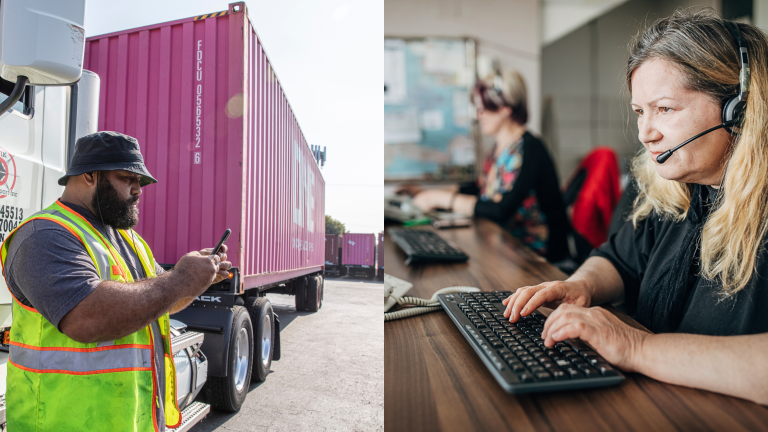In today’s fast-paced supply chain landscape, the role of drayage in facilitating seamless intermodal transportation has gained increasing recognition. As the industry evolves, innovative technologies and collaborative efforts are reshaping the way drayage operates. Similarly, the future of supply chain management hinges on enhanced collaboration among stakeholders and the strategic integration of technology.
In a recent conversation with Let’s Talk Supply Chain, Dennis Lane, Travis Barnier, and Mark Picarello delved into the key trends and solutions shaping intermodal trucking and container drayage. Here are some of our takeaways from the session. You can watch the entire conversation below or on Let’s Talk Supply Chain’s YouTube channel here.
The State of Drayage Today
The traditional perception of drayage as a mere logistical step in the supply chain is evolving. Organizations now recognize drayage as a key element of the entire intermodal shipment lifecycle, so innovators and technology providers are stepping up to revolutionize the capabilities of drayage operations. From enhancing visibility and workflow efficiency to tackling compliance issues and cost reduction, new drayage technologies are driving transformative change in the industry.
Collaboration emerges as a pivotal force driving progress in both the drayage and supply chain sectors. It encompasses cooperation among internal stakeholders, external partnerships, clients, and even competitors. By fostering collaboration, organizations can navigate challenges more effectively and capitalize on opportunities for growth and innovation.
Trend 1: Digitization Revolutionizes Operations
Digitization in drayage involves the transition from manual processes to automated, digital solutions across all aspects of operations. This includes internal operations, customer interactions, and connectivity with external partners.
The key effect of digitizing is removing manual touchpoints. Processed manually, the average drayage move can require over 20 manual touchpoints. With the right system and digital processes, that can be reduced to just 3 or 4 touchpoints. When scaled across thousands of orders, the efficiency gains are tremendous.
When a company undergoes digitization, it helps the business overcome taxing operational challenges and begin to reap the benefits of streamlining the quoting and booking processes, improving invoicing accuracy, enhancing communication and collaboration among stakeholders, and optimizing resource utilization.
Organizations should approach digitization strategically, considering factors such as budget, time frames, and staffing capabilities. Prioritizing key areas of improvement and adopting a phased approach can facilitate smooth implementation and maximize returns on investment.
Trend 2: Collaboration Enhances Industry Dynamics
Collaboration in both drayage and supply chain management involves synergistic efforts among various stakeholders, including internal teams, external partners such as marine terminals, railroads, trucking associations, clients, customers, and even competitors within the industry.
As the critical link between maritime and inland transportation, intermodal trucking is collaborative by nature. Sitting at the intersection of multiple modes of transportation, it is important for drayage operators to play a role in facilitating collaboration. Often, collaboration emerges when transparency, trust, and communication are demonstrated from the moment a business relationship starts.
3 ways carriers can promote collaboration are:
- Execute operations digitally in software developed specifically for container drayage and intermodal moves. When the lifecycle of an intermodal shipment is managed digitally, carriers have access to every piece of information in one place, which makes it significantly easier and faster to communicate shipment information with customers. Keeping sensitive information secure digitally instills trust.
- Reduce manual communication during the quoting process. Give customers 24/7 access to your rates through a secure online system, display capacity upfront, and maintain standard quotes that are clear and accurate for all charges and accessorials.
- Use digital tools to maintain visibility on intermodal equipment when it is parked and stored. Opt to use an online marketplace to book storage space, and work with supplier yards that have the level of security needed.
Collaboration between stakeholders and carriers improves operational efficiency and productivity, enhances problem-solving capabilities and innovation, increases industry resilience, facilitates greater adaptability to change, and strengthens client and partner relationships.
Trend 3: Interconnectivity Fuels Innovation
Interconnectivity is both a facilitator and byproduct of collaboration. System interconnectivity with up-stream and down-stream supply chain partners allows for more fluidity in data flow, thus enabling collaboration in a technical capacity. It is also a byproduct of collaboration, as new solutions are often developed due to existing collaborative business relationships that innovate together.
Currently, customers are more likely to scrutinize drayage companies on the quality and accuracy of their shipment data, than on their on-time performance of container deliveries. This is indicative of a broader emphasis on data-driven decisions within the supply chain. Therefore, there is a pressure on drayage companies to maintain clean, constant, and accurate data that they can easily share with customers.
Beyond having company data digitized, this involves interconnectivity with other systems and data sources. To be flexible and meet the needs of their customers, draymen need to invest in technology that is capable of interconnecting with a variety of systems to provide the level of visibility that customers require.
The Impact of Digitization, Collaboration, and Interconnectivity on Drayage in 2024
The future of many drayage companies hinges on enhanced collaboration among stakeholders and the strategic integration of technology. From leveraging transportation management systems (TMS) to real-time tracking capabilities, companies can offer their customers a better overall experience while optimizing their own processes.
Transparency and visibility within the supply chain are key drivers of collaboration. By sharing data and leveraging interconnected systems, stakeholders can adapt more effectively to market fluctuations and operational challenges, improving operational efficiency, customer satisfaction, and retention.
Technology adoption is not exclusive to large enterprises. Smaller carriers can also benefit from cost-effective solutions such as TMS platforms offered via software-as-a-service (SaaS) model, driver mobile apps, rate management and quoting software, online truck and container parking and storage, and more. These solutions offer an immense ROI and enable small businesses to streamline operations and compete more effectively.
Future Trends and Challenges
Looking ahead to 2024 and beyond, several trends are expected to shape both the intermodal trucking and supply chain landscape. These include the continued digitization of processes, the adoption of AI-driven automation, the emergence of dynamic pricing models, and challenges such as driver classification issues and regulatory changes.
As drayage and the global supply chain landscape continues to evolve, embracing digitization and fostering collaboration emerge as critical strategies for success. By harnessing the power of technology and collaborative efforts, organizations can overcome challenges, drive innovation, and build a more resilient and efficient intermodal trucking ecosystem. In the ever-evolving world of supply chain logistics, staying ahead requires a commitment to embracing change and leveraging collaborative solutions for a brighter future.
Beyond Drayage TMS Live with Let’s Talk Supply Chain
Our very own Dennis Lane, Travis Barnier, and Mark Picarello were featured on a Let’s Talk Supply Chain LinkedIn Live with Sarah Barnes Humphrey to talk about these topics in depth. To listen to the full conversation, watch here!




